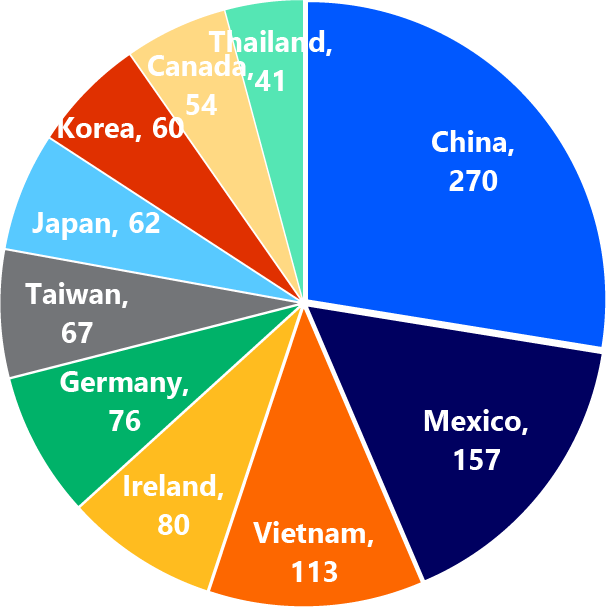The US’s relatively small trade deficit with New Zealand has so far helped keep New Zealand food and agri exports off the US trade tariff ‘wheel of misfortune’, but the tariff threat remains, Rabobank says in a newly-released global report.
The report, The impact of US tariffs on global food and agribusiness, explores the new series of trade policies and tariffs from the newly-re-elected President Trump administration and their potential global impacts on food and agriculture. It identifies nine waves of economic and geopolitical measures that have been imposed, are underway or likely under the new US administration.
These range from the ‘first wave’ announced by the new administration against Colombia – a major supplier of US coffee and cut flower imports – to the most recently-announced ‘ninth wave’ of tariffs on steel and aluminium imports into the US, which may disrupt supply or increase costs for beverage and food packaging.
Their effects are already starting to be felt on “foreign shores”, according to report co-author, RaboResearch general manager Australia & New Zealand Stefan Vogel, and their potential impacts on global food and agribusiness range from minor ripple effects to heavy disruptions.

General Manager RaboResearch Australia and New Zealand, Stefan Vogel
“It has been a stormy start to the year with many waves and more to be expected later in 2025,” Mr Vogel said.
To date, Mr Vogel said, New Zealand’s food and agri products have avoided US tariffs, with this likely largely down to the fact the US holds a relatively minor trade deficit with New Zealand.
“The US trade deficit with New Zealand was just over USD 1 billion for the period from January to November 2024 and, in total over timeframe, the value of NZ exports to the US was roughly 25% higher than for US imports heading this way,” he said.
“The US’s immediate focus has been on other countries with much larger trade deficits, but that doesn’t mean New Zealand is out of the woods given the new US administration’s stated desire to balance trade deficits.
“New Zealand also uses a relatively low share of GDP for defence spending, and this is another factor the US consider when implementing tariffs.”
‘Wheel of misfortune’
The report says countries which have significant trade surpluses with the United States – such as China, Mexico and Canada – are at higher risk of facing further tariffs. And this could lead to further increased costs and disruptions in global trade.
“President Trump has stated many times that he is especially targeting countries with whom the US holds a heavy trade deficit,” Mr Vogel said.
“China and Mexico are top on that list, but Canada also makes the list of the top 10 countries with whom the US has a trade deficit. EU countries also make up a large share as do various Asian economies.”
Wheel of misfortune – US top 10 trade deficits by country (billion USD), Jan-Nov 2024

Source: US Census Bureau, RaboResearch 2025
New Zealand
The report says animal proteins are the key food and agri exports out of New Zealand at risk of facing US import tariffs.
“In 2024, the US overtook China as the largest export destination for New Zealand meat.” Mr Vogel said.
“This was dominated by beef exports with approximately 40% of New Zealand’s 2024 beef exports going to the US, ahead of China at 30%.
“New Zealand accounted for 14% of total US beef import volumes, while, in value terms, the US is the second-largest destination for New Zealand sheepmeat after China.”
Mr Vogel said New Zealand also exported significant volumes of dairy products and wine to the US.
“About 6% of New Zealand’s total dairy exports head to the US while they are also our top export destination, making up about one-third of total New Zealand wine exports,” he said.
Nine waves
The report says current US policy is using tools of “statecraft”, such as tariffs, to achieve wider political goals and, in doing so, creating waves that are hitting shores abroad. Food and agribusiness sectors will see wide-ranging impacts across the globe and along the entire supply chain, it says.
The nine waves and some potential impacts on global food and agriculture include:
•Colombia – significant impacts for US imports of cut flowers and coffee;
•Mexico and Canada – 25 per cent tariffs on most goods, along with a 10 percent tariff on Canadian energy imports. Could heavily impact energy sector and agricultural supply in North America, increasing costs;
•China – a 10 per cent tariff imposed on Chinese goods. Retaliatory measures from China have been put in place, but do not yet affect major US agricultural exports like soybeans;
•Ukraine – to ensure continued financial and military support a US-Ukraine deal that would give the US access to Ukraine’s vast supplies of rare earths including lithium is in the final stages;
•Houthis (Red Sea/Suez Canal) – recent US pressure on the Houthis rebels and the Hamas-Israel ceasefire agreement have seen the Houthis announce they would cease attacks on most vessels in the canal;
•Panama Canal – President Trump has expressed a desire to take back control of the canal, a crucial shipping route for US trade. This could have significant implications for global maritime agricultural trade;
•Europe – the EU may face US tariffs on products, including machinery and pharmaceuticals as well as spirits, wine and agricultural goods;
•US Agency for Development (USAID) – funding cuts have impacts for agriculture, with the agency, which administers foreign aid and development assistance, having purchased USD 2 billion in US-grown crops in 2024;
•Steel and aluminium tariffs – increased US tariffs on steel and aluminium may disrupt supply and increase packaging costs for food and beverage manufacturers.
RaboResearch Disclaimer: Please refer to our disclaimer here for information about the scope and limitations of the RaboResearch material provided in this media release.
